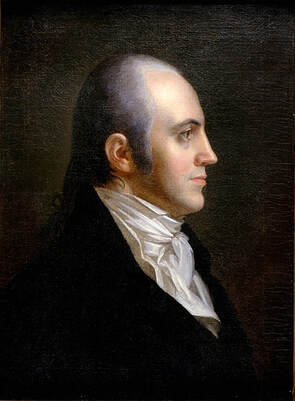 Aaron Burr
Aaron Burr After Burr left the vice-presidency at the end of his term in 1805, he journeyed to the Western frontier, areas west of the Allegheny Mountains and down the Ohio River Valley eventually reaching the lands acquired in the Louisiana Purchase. Burr had leased 40,000 acres (16,000 ha) of land—known as the Bastrop Tract—along the Ouachita River, in present-day Louisiana, from the Spanish government. Starting in Pittsburgh and then proceeding to Beaver, Pennsylvania, and Wheeling, Virginia, and onward he drummed up support for his planned settlement, whose purpose and status was unclear.
His most important contact was General James Wilkinson, Commander-in-Chief of the U.S. Army at New Orleans, and Governor of the Louisiana Territory. Others included Harman Blennerhassett, who offered the use of his private island for training and outfitting Burr's expedition. Wilkinson would later prove to be a bad choice.
Burr saw war with Spain as a distinct possibility. In case of a war declaration, Andrew Jackson stood ready to help Burr, who would be in a position to join in immediately. Burr's expedition of about eighty men carried modest arms for hunting, and no war materiel was ever revealed, even when Blennerhassett Island was seized by Ohio militia. The aim of his "conspiracy," he always avowed, was that if he settled there with a large group of armed "farmers" and war broke out, he would have a force with which to fight and claim land for himself, thus recouping his fortunes. However, the war did not come as Burr expected: the 1819 Adams–Onís Treaty secured Florida for the United States without a fight, and war in Texas did not occur until 1836, the year Burr died.
After a near-incident with Spanish forces at Natchitoches, Wilkinson decided he could best serve his conflicting interests by betraying Burr's plans to President Jefferson and his Spanish paymasters. Jefferson issued an order for Burr's arrest, declaring him a traitor before any indictment. Burr read this in a newspaper in the Territory of Orleans on January 10, 1807. Jefferson's warrant put Federal agents on his trail. Burr twice turned himself into Federal authorities, and both times judges found his actions legal and released him.
Jefferson's warrant, however, followed Burr, who fled toward Spanish Florida. He was intercepted at Wakefield, in Mississippi Territory (now in the state of Alabama), on February 19, 1807. He was confined to Fort Stoddert after being arrested on charges of treason.
Burr's secret correspondence with Anthony Merry and the Marquis of Casa Yrujo, the British and Spanish ministers at Washington, was eventually revealed. He had tried to secure money and to conceal his true designs, which was to help Mexico overthrow Spanish power in the Southwest. Burr intended to found a dynasty in what would have become former Mexican territory. This was a misdemeanor, based on the Neutrality Act of 1794, which Congress passed to block filibuster expeditions against U.S. neighbors, such as those of George Rogers Clark and William Blount. Jefferson, however, sought the highest charges against Burr.
In 1807, Burr was brought to trial on a charge of treason before the United States Circuit court at Richmond, Virginia. His defense lawyers included Edmund Randolph, John Wickham, Luther Martin, and Benjamin Gaines Botts. Burr had been arraigned four times for treason before a grand jury indicted him on May 22, 1807. The only physical evidence presented to the Grand Jury was Wilkinson's so-called letter from Burr, which proposed the idea of stealing land in the Louisiana Purchase. During the Jury's examination, the court discovered that the letter was written in Wilkinson's handwriting. He said he had made a copy because he had lost the original. The Grand Jury threw the letter out as evidence, and the news made a laughingstock of the General for the rest of the proceedings.
The trial, presided over by Chief Justice of the United States John Marshall, began on August 3. Article 3, Section 3 of the United States Constitution requires that treason either be admitted in open court, or proven by an overt act witnessed by two people. Since no two witnesses came forward, Burr was acquitted on September 1, despite the full force of the Jefferson administration's political influence thrown against him. Burr was immediately tried on a misdemeanor charge and was again acquitted.
Given that Jefferson was using his influence as president to obtain a conviction, the trial was a major test of the Constitution and the concept of separation of powers. Jefferson challenged the authority of the Supreme Court, specifically Chief Justice Marshall, an Adams appointee who clashed with Jefferson over John Adams' last-minute judicial appointments. Jefferson believed that Burr's treason was obvious. Burr sent a letter to Jefferson in which he stated that he could do Jefferson much harm. The case, as tried, was decided on whether Aaron Burr was present at certain events at certain times and in certain capacities. Thomas Jefferson used all of his influence to get Marshall to convict, but Marshall was not swayed.
 RSS Feed
RSS Feed